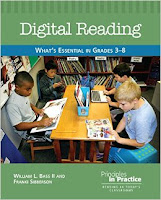
This week's reading reminded me of previous experiences I've had with digital tools and trying to connect with parents. As I read the chapters I was able to really reflect on what I've done in the past, the present, and how I want to expand or change what I do now.
About 6 years ago when I was teaching second grade in a different building I became very interested in using more technology in my classroom. I had been lucky enough to be one of a few teachers to have a Smartboard installed the previous year and had begun to see the possibilities for connecting my students to the outside world beyond our classroom and school. This realization came shortly after I started using Twitter. I had 2 computers in my classroom and that was all that was available. (LOL At least I have a computer lab in my new building!) I had heard about a set of Netbooks that were available to borrow from a Teacher Center about 15 minutes away. After
Love this quote from the book - great message - The Internet is a place where reading happens.
I will add to that: The Internet is a place where reading, writing and learning happens. It's a place to connect, create, collaborate and share. That is the message I want both my students and parents to hear.
Connecting with parents is very important to me, but I often feel like only a handful of families really know what is going on in our classroom. And so little student work actually goes home regularly because of the nature of a workshop classroom. Everything is in a notebook and I don't give regular traditional tests. I have a website with details about our day-to-day running of the classroom and helpful websites for home. We have a class blog where we write about our learning and share some of our class work. Only a few parents ever, if rarely post a comment to our blog. (Hmm...maybe they don't know how to do this?) This communication problem extends to our report cards which are only available online, unless parents request a printed version. We are able to find out how many parents log on and how often, and let me say it is not a very good statistic! Most of the elementary teachers report less that 10 families looking at the report card. There have been many conversations in the faculty room as to why we have such a poor interest in the report card. I think there are several reasons, but one that comes to mind after this weeks reading is understanding the digital tools. Do my parents know how to access the report card? Is the information meaningful to them? I'm guessing it may not be. I really need to find a better way to communicate with my parents about their student's learning. One thing I want to try more is student made videos - either tutorials or general information about our learning.
Franki suggests setting up communication goals for the year. So that is what I'm going to do right now!
- I want my students to be able to connect with family, fellow classmates and more global audiences.
- I want to have a space to share our learning.
- I want to have a hub for general information and class activities.
- I want my students to learn how to use the Internet safely and with good etiquette.
- I would like to explore sharing individual work and information with parents digitally.
I have a class blog and I know I can use it better! My students enjoy commenting when in the computer lab, but few comment from home. I also want to increase our global audience. I think I will start a Class Twitter account! Trying to get parents more involved is a challenge. I though about having a Class Facebook page, because I know most of the parents have a Facebook page! It's the one social media place I have not entered yet. I use Instagram and Pinterest for personal use. Our district recently discontinued the platform we used for our teacher websites and is now using Google, so I am currently building my class site. All of the information I have learned from this #cyberPD will help me a lot.
It has been great reading this book with other educators! I can't wait to read other posts and comments.